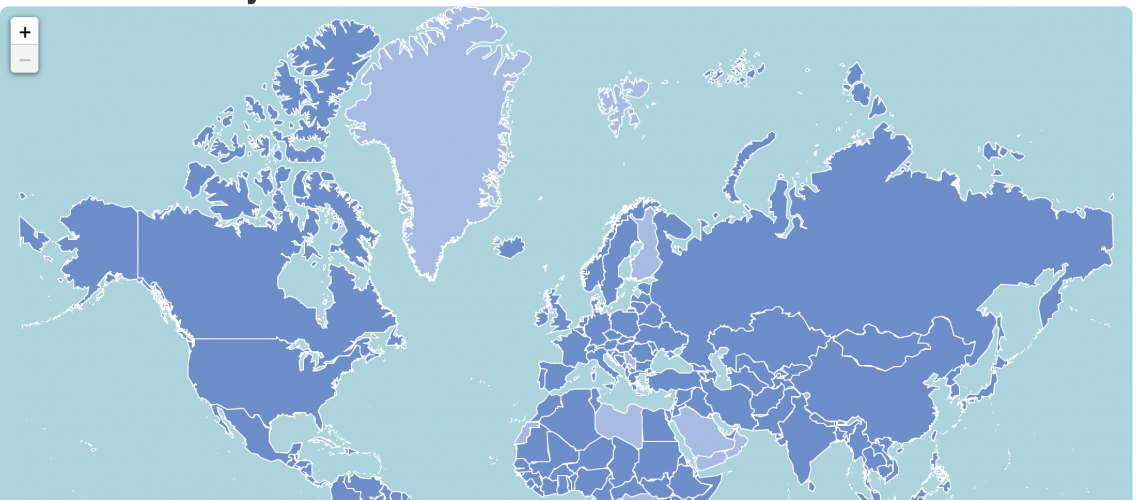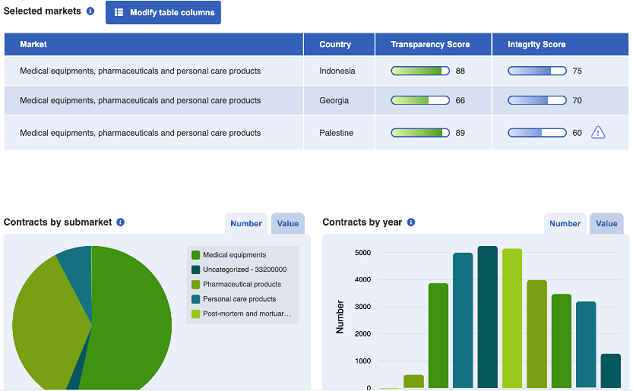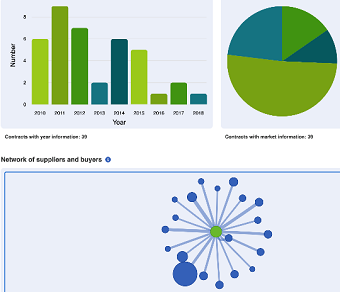New Global Anticorruption and Transparency Platform (ProACT) empowers stakeholders to use data to have an impact on integrity in public procurement

Example of the interactive map accessible on the ProACT platform
Have you ever wondered how different governments procure goods, works, and services and what integrity risks may be affecting these procedures? In an increasingly globalized world it is challenging for national authorities and civil society organizations to monitor and assess the integrity and transparency of public procurement. Companies participate in public procurement tenders in multiple countries, and corruption risks differ across sectors and markets. Aggregated cross-country data sets do not exist, and doing this kind of analysis requires time and investment.
The World Bank, in partnership with the Government Transparency Institute, has developed a new Procurement, Anticorruption, and Transparency platform (ProACT) to help users identify these risks, and to support efforts to understand how and where the risks are adding to the costs of public procurement and undermining outcomes.
The ProACT platform – which is being launched as a prototype to gather feedback from a wide range of users – provides easy access to open public procurement data from 110 countries for the period 2006-2020 (this includes national procurement data from 45 countries as well as data related to contracts financed by the World Bank).
ProACT applies integrity and transparency risk indicators that have been developed to be applicable globally (see more about the methodology here). The integrity risk indicators are based on types of corruption that are specific to public procurement and are detectable with open public procurement data. This includes deviations from or non-compliance with rules governing public procurement processes, patterns that suggest the manipulation of outcomes, and the distortion of competition. Transparency indicators assess which types of information relating to public procurement processes are publicly available. A high score on Transparency Indicators indicates a high level of accessibility of public procurement data (see the indicators used in the tables below). Additional indicators and types of data are being considered to enhance the analysis of risk or to include new procurement performance dimensions.
Integrity Risk Indicators Used in the Prototype
|
Risk indicator |
Category of indicator |
Level of calculation |
|
Use of non-open procedure types |
Procurement process risk |
Contract |
|
Call for tenders is published |
Procurement process risk |
Contract |
|
Length of advertisement period (time between tender advertisement and the submission deadline) |
Procurement process risk |
Contract |
|
Single bidder contract |
Procurement process risk |
Contract |
|
Length of decision period (time between submission deadline and contract award decision date) |
Procurement process risk |
Contract |
|
Benford's law |
Procurement process risk |
Buyer |
|
Supplier’s contract share of buyer spending on public procurement |
Supplier risk |
Supplier |
|
Supplier is registered in a tax haven |
Supplier risk |
Supplier |
|
Delivery delay (relative contract length increase) |
Procurement process risk |
Contract |
|
Cost overrun |
Procurement process risk |
Contract |
Transparency Risk Indicators Used in the Prototype
|
Available buyer name |
|
Available contract title |
|
Available supplier name |
|
Available supply type |
|
Available contract value |
|
Available buyer/implementation location |
|
Available procedure type |
|
Available number of bids |
|
Available award date |
What does ProACT do?
The platform is intended to help a range of users including public procurement officials, civil society actors, anticorruption researchers and international organizations to do the following:
- Gain access to information about markets: such as what governments are buying, which suppliers are winning public tenders, and the size and share of contracts in different markets, providing insights on the volume, values, and efficiency of procurement processes and systems.
- Identify contracts, tenders, buyers, and suppliers that present high risk across the integrity and transparency indicators, including the use of non-transparent procedures, single bidding, short or long delays in the award of contracts, and where prices might have been manipulated according to Benford’s law. These insights can contribute to strengthening policies and procedures to address vulnerabilities, and prevent and sanction wrongdoing.
- Visualize suppliers and buyer bidding networks for a selection of countries where the available data enables this kind of analysis. The ability to visualize relationships can assist in the detection and analysis of collusive and anti-competitive practices in public procurement.
- Identify prior contracts and available sanctions data for firms. Sanctions data is included for information purposes in the prototype, drawn from a selection of sanctioning authorities (see the methodology for more information). Collecting and aggregating sanctions decisions data remains a challenging task and the methodology is still being enhanced.
Here’s an example of how we used ProACT. This video explains how you can use the platform.
Easy to understand visualizations help explain the data in ProACT


Editor’s Note:
ProACT is a project supported by the Global Procurement Partnership Multi-Donor Trust Fund (GPP MDTF), a Bank-administered fund for supporting public procurement reforms at the global and country levels. The GPP MDTF is implemented with contributions from the Agence Française de Développement, European Commission, Ministry of Foreign Affairs of the Netherlands, and Swiss State Secretariat for Economic Affairs. The project benefits from the use of open public procurement data that was collected with the support of the Government of the United Kingdom FCDO and the European Union Horizon 2020.
